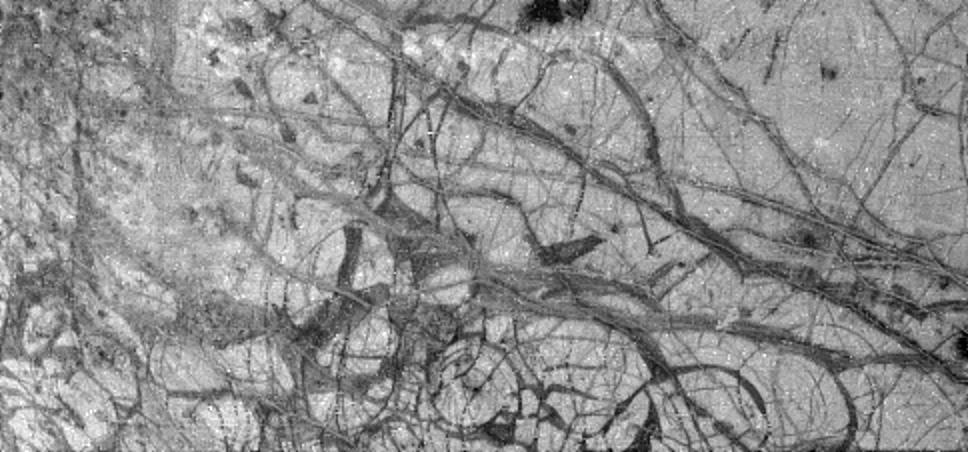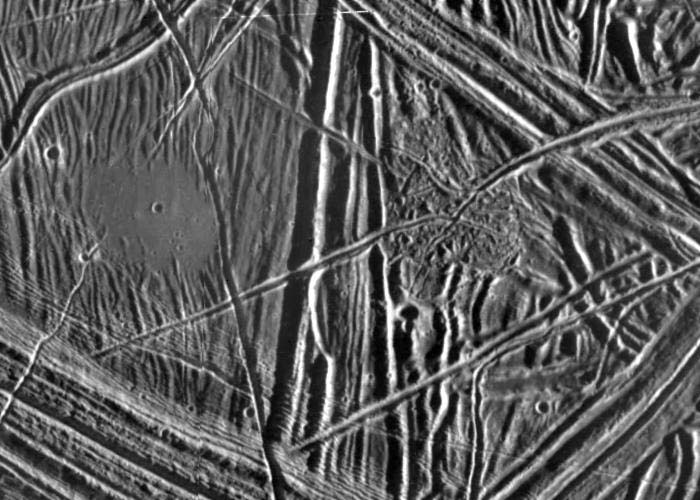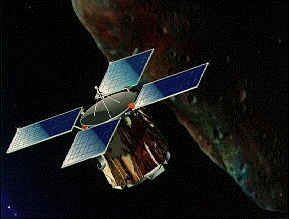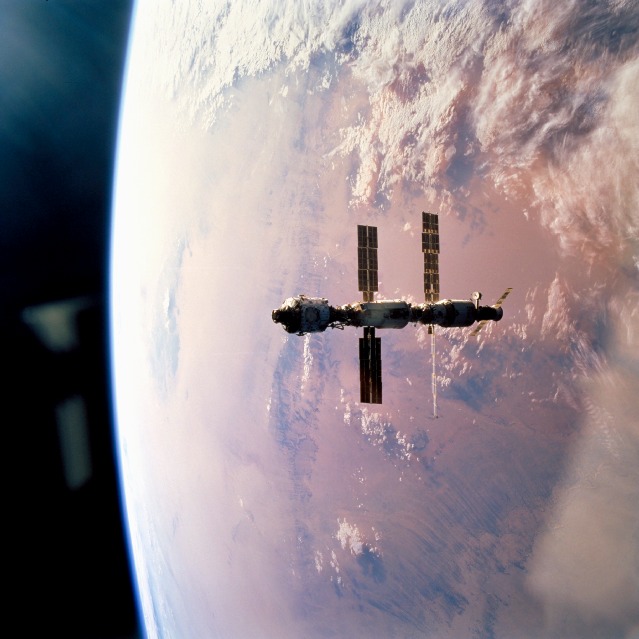






Selected Articles from the
December 2000 Odyssey
Editor: Terry Hancock
The Year 2000
Standing here, in the last month of the twentieth century, it seems like a good time to take some stock in where we are in space.
While 1984 was, as Apple Computer promised us, not like 1984, it's pretty clear that 2001 won't be like 2001 either. But the year 2000 has seen some promising events and powerful discoveries in space.
The Year in Space
Abridged NASA Press Releases
Part 2 of The Year in Space.
Possible Water World under Europa's Icy Crust
January 10, 2000 & August 25, 2000
When NASA's Galileo spacecraft swooped past Jupiter's moon Europa a week ago, it picked up powerful new evidence that a liquid ocean lies beneath Europa's icy crust.
 |
| Image covers part of the equatorial zoneof Europa and was taken from a distance of 156,000 kilometers. NASA. Click here to enlarge. |
As the spacecraft flew 218 miles (351 kilometers) above the icy moon on January 3, its magnetometer instrument studied changes in the direction of Europa's magnetic field. Galileo's magnetometer observed directional changes consistent with the type that would occur if Europa contained a shell of electrically conducting material, such as a salty, liquid ocean.
 |
| Close-up view of the icy surface of Europa. NASA. Click here to enlarge. |
"I think these findings tell us that there is indeed a layer of liquid water beneath Europa's surface," said Dr. Margaret Kivelson, principal investigator for the magnetometer. "I'm cautious by nature, but this new evidence certainly makes the argument for the presence of an ocean far more persuasive."
It is not likely that the electric currents on Europa flow through solid surface ice, Kivelson explained, because ice is not a good carrier of currents. "But melted ice containing salts, like the sea water found on Earth, is a fairly good conductor," she said.
There is no other likely current-carrying material near Europa's surface, Kivelson added. "Currents could flow in partially melted ice beneath Europa's surface, but that makes little sense, since Europa is hotter toward its interior, so it's more likely the ice would melt completely. In addition, as you get deeper toward the interior, the strength of the current-generated magnetic field at the surface would decrease." Galileo has flown near Europa frequently since the spacecraft began orbiting Jupiter and its moons in December 1995. Pictures from those flybys show patterns that scientists see as evidence of a hidden ocean. In some, rafts of ice appear to have shifted position by floating on fluid below. In others, fluid appears to have risen to the surface and frozen.
Europa has long been suspected of harboring vast quantities of water. Since life as we know it requires water, this makes the moon a prime target for the search of exobiology - life beyond Earth.
NASA is planning a Europa oribiter mission to carry instruments capable of providing more information.
NEAR Shoemaker Mission
March 14, 2000
 |
| Artist's conception of Near Shoemaker spacecraft. NASA |
The NASA satellite conducting the first-ever close-up study of an asteroid will be renamed to honor Dr. Eugene M. Shoemaker, a legendary geologist who influenced decades of research on the role of asteroids and comets in shaping the planets. The Near Earth Asteroid Rendezvous (NEAR) spacecraft, currently orbiting asteroid 433 Eros more than 145 million miles from Earth, will now be known as NEAR Shoemaker.
"Gene Shoemaker was an inspirational, charismatic pioneer in the field of interplanetary science," said Dr. Carl B. Pilcher.
- http://near.jhuapl.edu
- http://wwwflag.wr.usgs.gov/USGSFlag/Space/Shoemaker/GeneObit.html
- SPACECRAFT RENAMED FOR PLANETARY SCIENCE PIONEER
International Space Station Inhabited
Oct. 30, 2000
 |
| ISS as seen from STS-92 shuttle flight. NASA. Click here to enlarge. |
American astronaut Bill Shepherd will launch a new era in space history Oct. 31, when he lifts off in a Russian Soyuz spacecraft from the Baikonur Cosmodrome in Kazakhstan en route to his new home aboard the International Space Station. If all goes well on this and future missions, Oct. 30, 2000, will be the last day on which there were no human beings in space.
Shepherd, of Babylon, NY, is commander of the three-person Expedition 1 crew, the first of several crews that will live aboard the space station for periods of about four months. He will be accompanied by cosmonauts Yuri Gidzenko, commander of the Soyuz, and flight engineer Sergei Krikalev on this historic journey.
Aboard the station, the crew will help with assembly tasks as new elements, including the US Laboratory, are added to the orbiting outpost. They will also conduct early science experiments.
Part 2 of The Year in Space.
Copyright © 1998-2003 Organization for the Advancement of Space Industrialization and Settlement. All Rights Reserved.